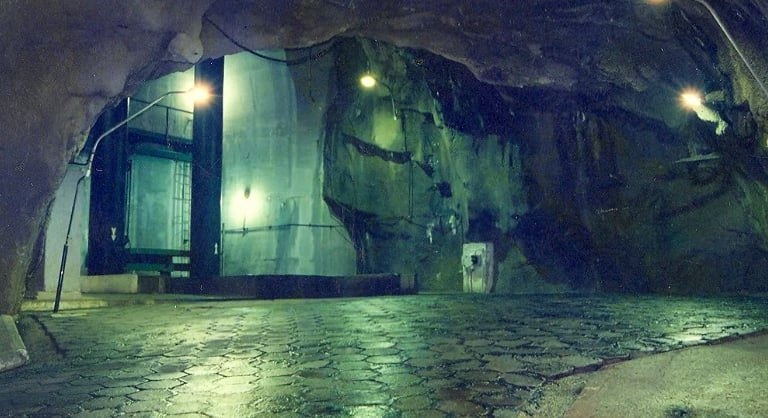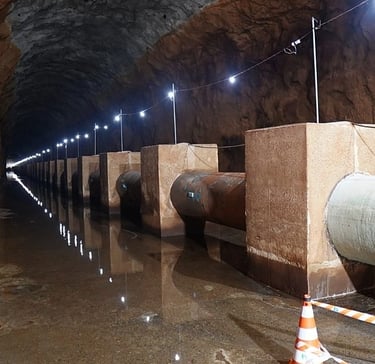Santa Tereza/Voturuá Reservoir: Engineering Thirst Quenching Brazil's Coastline
Santa Tereza/Voturuá Reservoir: Engineering Thirst Quenching Brazil's Coastline and Driving Development. The escalating demand for potable water along Brazil's Baixada Santista coastline, fueled by urban and industrial expansion, urgently required a robust and efficient solution. The Driving Development.
Everton Faustino
5/1/20253 min leer


Inside the mountain - Santa Tereza - Voturuá Water Reservoir.
The monumental Santa Tereza/Voturuá Reservoir emerged as an engineering marvel, transforming the region's water supply landscape.
The discovery of the solution to ensure a continuous water supply resonated with the strategic vision of Sabesp, the state's water utility, which identified the area nestled between the hills of São Vicente and Santos as a geographically strategic point for constructing a large-scale reservoir. The inspiration for the project lay in the long-term necessity for water security, replicating successful models from other regions and adapting them to the local topography and specific characteristics.
The technology employed in the construction of the Santa Tereza/Voturuá Reservoir represented a significant advancement for its time. Rock excavation techniques, large-volume concrete pouring, and high-performance waterproofing were crucial in erecting the imposing structure capable of storing billions of liters of water. The investment value in the project was substantial, reflecting its complexity and magnitude, yet essential to guarantee the quality of life and sustainable development of the region.
The realization of the construction was not without its difficulties. The rugged terrain, the need to divert pre-existing watercourses, and the complex logistics for transporting materials posed significant challenges for the engineering and construction teams. The total cost of the project, while considerable, was justified by the long-term benefits the reservoir would bring to the population. Potential reverses, such as construction delays and environmental impacts during the implementation phase, were mitigated through careful planning and rigorous control measures.
The construction time, which spanned several years, demanded patience and coordination among the various stakeholders involved. However, the wait proved worthwhile. The advantages of the Santa Tereza/Voturuá Reservoir are numerous: increased water storage capacity, guaranteed supply even during drought periods, improved pressure in the distribution network, and greater water security for the population of Baixada Santista.
The result for the population is tangible. Residents and businesses in the region now benefit from a more reliable and stable water supply, boosting economic growth, quality of life, and social well-being. The Santa Tereza/Voturuá Reservoir has solidified its position as a landmark of Brazilian engineering and an example of how well-planned and executed infrastructure can transform the lives of thousands.
In conclusion, the Santa Tereza/Voturuá Reservoir is not merely a structure of concrete and water; it is a symbol of human capacity to overcome challenges and build a safer and more prosperous future for communities. Its story of necessity, innovative solution, and positive impact resonates as a legacy for future generations along Brazil's coast.
The Santa Tereza/Voturuá Reservoir, while crucial for the Baixada Santista, finds parallels in other large-scale water storage projects globally. Unlike some gravity-fed systems reliant on mountainous terrain, its construction in a relatively flatter coastal region highlights innovative engineering solutions for water security. Compared to purely single-purpose reservoirs focused solely on water supply, Santa Tereza/Voturuá primarily addresses domestic and industrial needs, differing from multi-purpose dams that might also incorporate hydroelectric power generation or flood control. Projects like the Thames Water Ring Main in London, focused on distribution rather than raw water storage, represent a different approach to urban water resilience. The scale of Santa Tereza/Voturuá, holding billions of liters, positions it among significant regional water security infrastructures, though it might not reach the capacity of mega-dams found in larger river basins. Its success underscores the importance of localized, strategically placed reservoirs in ensuring water independence for densely populated coastal areas facing unique hydrological challenges.


Keywords: Santa Tereza Reservoir, Voturuá Reservoir, Water supply Baixada Santista, Water solution, Civil engineering, Construction technology, Infrastructure investment, Social impact, Sabesp.
